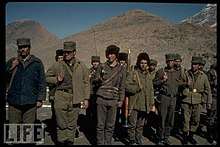Sarandoy
The Sarandoy or Sarondoy (Pashto:څارندوی - "Defenders (of the Revolution")) were a militarized gendarmerie force of the Soviet-backed Democratic Republic of Afghanistan in the 1980s,[1] during the Soviet–Afghan War.
| Sarandoy | |
|---|---|
 Sarandoy gendarmes at a checkpoint (LIFE magazine) | |
| Active | 1978–1992 |
| Country | |
| Allegiance | Democratic Republic of Afghanistan |
| Branch | Ministry of the Interior |
| Type | Gendarmerie |
| Role | Internal security, Counter-insurgency |
| Size | 115,000 men (at height) |
| Headquarters | Kabul |
| Nickname(s) | "Defenders of the Revolution" |
| Engagements | Soviet–Afghan War Afghan Civil War (1989–1992) |
| Commanders | |
| Notable commanders | General Sayed Muhammad Gulabzoi |
Origins
Successor of the former Afghan Regional Gendarmerie, the Sarandoy were raised in 1978 with an initial strength of 30,000 officers and enlisted men, intended to be used on internal security duties.[2][3]
Structure and organization
Placed under the control of the Ministry of the Interior, the Sarandoy was commanded by the Minister of Interior General Sayed Muhammad Gulabzoi, a former Afghan Air Force officer.[4] At one point, the Sarandoy fielded some 115,000 men, compared to the Afghan Army's 160,000,[5] while at other times the Sarandoy were said to exceed the Army. Those who served in the Sarandoy were paid 162 dollars a month, a wage which was higher than that of Deputy Minister of National Defence before the April 1978 Saur Revolution.
The Sarandoy was subjected to internal politics,[6] as its forces were controlled by the Khalqi Communist faction, opposed to the Parchami Communist faction which controlled the KhAD intelligence services. Accordingly, armed clashes occurred on occasion between the Sarandoy and the KhAD.[7]
Mark Urban wrote in 1988 that '...By 1985 there were 20 identified Sarandoy Operational Battalions and Mountain Battalions. They were attached to provincial Sarandoy commands and include[d] armoured vehicles and light artillery. The Kabul Security Command controlled two mobile regiments (the 1st and 2nd)... A further four Sarandoy brigades/regiments have been identified in Badakhshan (24th Sarandoy Brigade), Kandahar, Baghlan and Parwan.'[8] At the beginning of 1986, operational control of some units passed to the new unified Ministry of State Security.
A number of previously Sarandoy tribal militia units were eventually upgraded to Afghan Army formations, as part of the regularization of the militia.[9] Among these units was the Ismaili 80th Division in Baghlan Province.
See also
References
- Craig Karp, (March 1988), US Department of State Bulletin.
- Isby and Volstad, Russia's War in Afghanistan (1986), p. 20.
- O'Ballance, Afghan Wars, Battles in a hostile land - 1839 to the present (revised edition 2002), p. 88.
- Urban, War in Afghanistan (1988), pp. 46 and 182.
- Milt Bearden; James Risen (6 May 2003). The main enemy: the inside story of the CIA's final showdown with the KGB. Random House Digital, Inc. pp. 310–. ISBN 978-0-679-46309-2. Retrieved 29 March 2011.
- Robert Johnson (2005). A region in turmoil: South Asian conflicts since 1947. Reaktion Books. pp. 176–. ISBN 978-1-86189-257-7. Retrieved 29 March 2011.
- Shaista Wahab; Barry Youngerman (2007). A brief history of Afghanistan. Infobase Publishing. pp. 166–. ISBN 978-0-8160-5761-0. Retrieved 29 March 2011.
- Urban, War in Afghanistan (1988), p. 226.
- Giustozzi, War, Politics and Society in Afghanistan, 1978-1992 (2000), page unknown.
Bibliography
- Antonio Giustozzi, War, Politics and Society in Afghanistan, 1978-1992, Georgetown University Press 2000. ISBN 978-0878407583, 0878407588
- Edgar O'Ballance, Afghan Wars, Battles in a hostile land - 1839 to the present, Brassey's, London 1993 (revised edition 2002). ISBN 1 85753 308 9
- David Isby and Ron Volstad, Russia's War in Afghanistan, Men-at-arms series 178, Osprey Publishing Ltd, London 1986. ISBN 0-85045-691-6
- Ken Guest, Afghanistan, in Flashpoint! At the Front Line of Today’s Wars, Arms and Armour Press, London 1994, pp. 9–37. ISBN 1-85409-247-2
- Mark Urban, War in Afghanistan, Palgrave Macmillan, London 1988. ISBN 978-0333432648, 0333432649
- Steven J. Zaloga, Wojciech Luczak and Barry Beldam, Armor of the Afghanistan War, Concord Publications, Hong Kong 1992. ISBN 978-9623619097, 962361909X